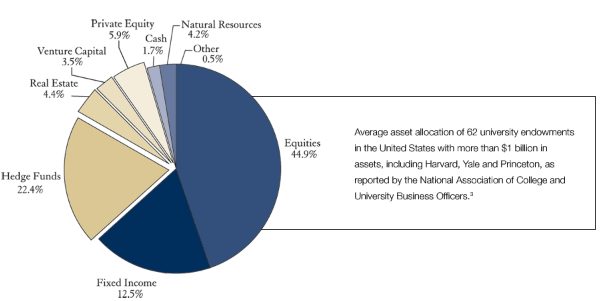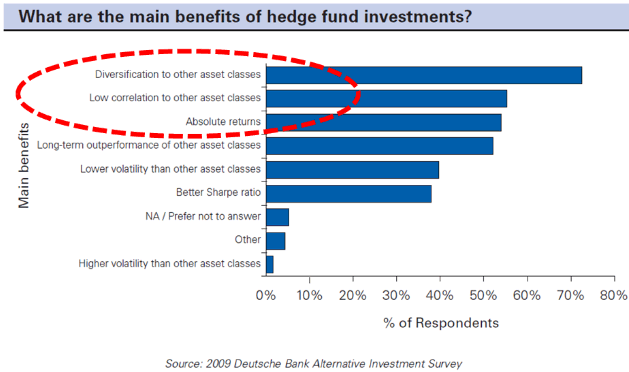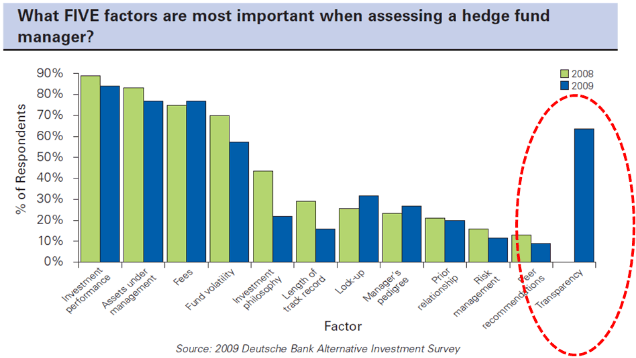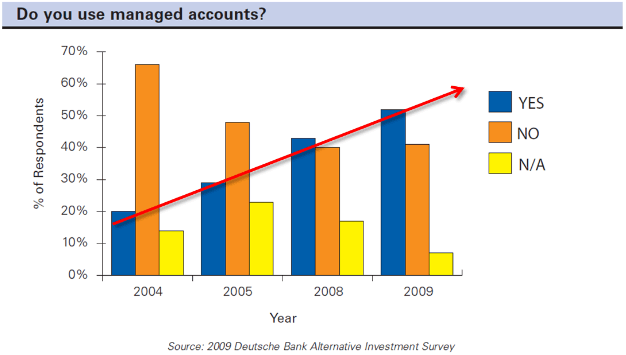An alternative investment is a product other than traditional investments, such as stocks, bonds, or cash. Most alternative investment assets are held by institutional investors or accredited, high-net-worth individuals because of their complex nature, limited regulations, and relative lack of liquidity. Some of the more common alternative investment strategies are real estate investment trusts, hedge funds, managed futures, private equity, venture capital, and limited partnerships. Wine, art, and antiques, indeed any value business, might also be considered an alternative investment. One common theme to alternative investments is that they are often hoped to have modest correlations with traditional investments, and so to increase the diversification of investors’ portfolios. Alternative investments are favored mainly because their returns have a low correlation with those of standard asset classes. Because of this, many significant institutional funds such as pensions and private endowments have begun to allocate a small portion (typically less than 10%) of their portfolios to alternative investments such as hedge funds. However, many alternative investments also have higher minimum investments and fee structures than mutual funds and ETFs. While they are subject to less regulation, they have less opportunity to publish verifiable performance data and advertise to potential investors. While the small investor may be shut out of some alternative investment opportunities, real estate and commodities vehicles such as REITs and Managed Futures are widely available.

Real Estate Investment Trusts (REITs)
A Real Estate Investment Trust or REIT is a tax designation for a corporation investing in real estate that reduces or eliminates corporate income taxes. In return, REITs are required to distribute 90% of their income, which may be taxable, into the hands of the investors. The REIT structure was designed to provide a similar structure for investment in real estate as mutual funds provide for investment in stocks. In the United States, a REIT is a company that owns and in most cases, operates income-producing real estate. In addition, some REITs finance real estate.
Like other corporations, REITs can be publicly or privately held. Public REITs may be listed on public stock exchanges like shares of common stock in other firms. In addition, REITs can be classified as equity, mortgage, or hybrid.
The key statistics to look at in a REIT are its NAV (Net asset value), AFFO (Adjusted Funds From Operations), and CAD (Cash Available for Distribution). REITs face challenges from a slowing economy and the global financial crisis, depressing share values by 40 to 70 percent in some cases.
To qualify for the advantages of being a pass-through entity for U.S. corporate income tax, a REIT must:
- Be structured as a corporation, trust, or association
- Be managed by a board of directors or trustees
- Have transferable shares or transferable certificates of interest
- Otherwise, be taxable as a domestic corporation
- Not be a financial institution or an insurance company
- Be jointly owned by 100 persons or more
- Have 95 percent of its income derived from dividends, interest, and property income
- Pay dividends of at least 90% of the REIT’s taxable income
- No more than 50% of the shares can be held by five or fewer individuals during the last half of each taxable year (5/50 rule)
- At least 75% of total investment assets must be in real estate
- Derive at least 75% of gross income from rents or mortgage interest
- No more than 20% of its assets may consist of stocks in taxable REIT subsidiaries.
Hedge Funds
A hedge fund is an investment fund open to a limited range of investors that is permitted by regulators to undertake a wider range of investment and trading activities than other investment funds and pays a performance fee to its investment manager. Each fund has its own strategy, which determines the type of investments and the methods of investment it undertakes. Hedge funds, as a class, invest in a broad range of investments including shares, debt and commodities. As the name implies, hedge funds often seek to offset potential losses in the principal markets they invest in by hedging their investments using a variety of methods, most notably short selling. However, the term “hedge fund” has come to be applied to many funds that do not actually hedge their investments, and in particular to funds using short selling and other “hedging” methods to increase rather than reduce risk, with the expectation of increasing return. Hedge funds are typically open only to a limited range of professional or wealthy investors. This provides them with an exemption in many jurisdictions from regulations governing short selling, derivative contracts, leverage, fee structures and the liquidity of interests in the fund. A hedge fund will typically commit itself to a particular investment strategy, investment types and leverage levels via statements in its offering documentation, thereby giving investors some indication of the nature of the fund.
The net asset value of a hedge fund can run into many billions of dollars, and this will usually be multiplied by leverage. Hedge funds dominate certain specialty markets such as trading within derivatives with high-yield ratings and distressed debt.
Hedge fund manager will typically receive both a management fee and a performance fee (also known as an incentive fee) from the fund. A typical manager may charge fees of “2 and 20”, which refers to a management fee of 2% of the fund’s net asset value each year and a performance fee of 20% of the fund’s profit. Management fees typically range from 1% to 4% per annum, with 2% being the standard figure. Typically, hedge funds charge 20% of returns as a performance fee. However, the range is wide, with highly regarded managers charging higher fees. For example, Steven Cohen’s SAC Capital Partners charges a 35-50% performance fee, while Jim Simons’ Medallion Fund charged a 45% performance fee.
Benefits
Investing in certain types of hedge funds can be a riskier proposition than investing in a regulated fund, despite a “hedge” being a means of reducing the risk of a bet or investment. Many hedge funds have some of these characteristics:
- Low Correlation – Hedge funds are typically lowly correlated or non-correlated with stocks and bonds. Adding a non-correlated asset class to a portfolio could improve its risk-adjusted performance. This aid to diversification is the most recognized feature of hedge funds.
- Expertise – Hedge fund managers may have disproportional advantages to market research and or data. His/her management in the fund may yield unusually high returns compared to other asset classes.
- Absolute Returns – Many hedge funds offer products that yield absolute returns, guaranteeing a certain return per year. This may be essential enhancements to many complex portfolios.
Risks
Investing in certain types of hedge funds can be a riskier proposition than investing in a regulated fund, despite a “hedge” being a means of reducing the risk of a bet or investment. Many hedge funds have some of these characteristics:
- Leverage – in addition to money invested into the fund by investors, a hedge fund will typically borrow money, with certain funds borrowing sums many times greater than the initial investment. If a hedge fund has borrowed $9 for every $1 received from investors, a loss of only 10% of the value of the investments of the hedge fund will wipe out 100% of the value of the investor’s stake in the fund, once the creditors have called in their loans.
- Short selling – due to the nature of short selling, the losses that can be incurred on a losing bet are theoretically limitless unless the short position directly hedges a corresponding long position. Therefore, where a hedge fund uses short selling as an investment strategy rather than as a hedging strategy, it can suffer very high losses if the market turns against it. Ordinary funds very rarely use short selling in this way.
- Appetite for risk – hedge funds are culturally more likely than other types of funds to take on underlying investments that carry high degrees of risk, such as high-yield bonds, distressed securities, and collateralized debt obligations based on sub-prime mortgages.
- Lack of transparency – hedge funds are secretive entities with few public disclosure requirements. It can therefore be difficult for an investor to assess trading strategies, diversification of the portfolio and other factors relevant to an investment decision.
- Lack of regulation – hedge funds are not subject to as much oversight from financial regulators as regulated funds, and therefore some may carry undisclosed structural risks
Notable Hedge Fund Firms
Amaranth Advisors, Bridgewater Associates, Citadel Investment Group, D.E. Shaw, Fortress Investment Group, GLG Partners, Man Group, Marshall Wace, Renaissance Technologies, Soros Fund Management, The Children’s Investment Fund Management (TCI).
Managed Futures Account
Disclaimer: While an investment in Managed Futures can help enhance returns and reduce risk, it can also do just the opposite and, in fact result in further losses in a portfolio. In addition, studies conducted of managed futures as a whole may not be indicative of the performance of any individual CTA. The results of studies conducted in the past may not be indicative of current time periods.
Managed futures is a form of alternative investment. Managed Futures is an industry in which professional money managers direct investments in the global currency, interest rate, equity, metal, energy, and agricultural markets. They do this through the use of futures, forwards, and options. Specifically, managed futures focus on taking long and short positions in futures contracts, government securities, and options on futures contracts. They are generally managed on the basis of technical analysis, but also could have an approach on the basis of fundamental analysis and involve going long or short in futures contracts in areas such as metals, grains, currencies, equity indexes, and commodities of all kinds. Because of the markets managed futures trade in and also because it takes a long/short trading approach, it may add substantial diversification to an investment portfolio. Potentially, they can enhance risk-adjusted rates of returns since managed futures’ returns have historically shown low correlation compared to stock and bond investments. Following modern portfolio theory, this lack of correlation builds the robustness of the portfolio, reducing portfolio volatility and risk, without significant negative impacts on return. This lack of correlation stems from the fact that managed futures draw their returns from different sources than traditional stock and bond investments. Consequently, managed futures can often return positive returns while stock and bond markets do not.
Private Equity
Private equity is an asset class consisting of equity securities in operating companies that are not publicly traded on a stock exchange. Investments in private equity most often involve either an investment of capital into an operating company or the acquisition of an operating company. Capital for private equity is raised primarily from institutional investors. There is a wide array of types and styles of private equity, and the term private equity has different connotations in different countries. Among the most common investment strategies in private equity include leveraged buyouts, venture capital, growth capital, distressed investments and mezzanine capital. In a typical leveraged buyout transaction, the private equity firm buys majority control of an existing or mature firm. This is distinct from a venture capital or growth capital investment, in which the private equity firm typically invests in young or emerging companies and rarely obtain majority control.
Private equity investments can be divided into the following categories:
- Leveraged buyout – LBO or Buyout refers to a strategy of making equity investments as part of a transaction in which a company, business unit or business assets is acquired from the current shareholders typically with the use of financial leverage. The companies involved in these transactions are typically mature and generate operating cash flows.
- Venture capital – a broad subcategory of private equity that refers to equity investments made, typically in less mature companies, for the launch, early development, or expansion of a business. Venture investment is most often found in the application of new technology, new marketing concepts and new products that have yet to be proven.
- Growth capital – equity investments, most often minority investments, in relatively mature companies that are looking for capital to expand or restructure operations, enter new markets or finance a major acquisition without a change of control of the business.[citation needed]
- Distressed and Special Situations – a broad category referring to investments in equity or debt securities of financially stressed companies. The “distressed” category encompasses two broad sub-strategies including:
- “Distressed-to-Control” or “Loan-to-Own” strategies where the investor acquires debt securities in the hopes of emerging from a corporate restructuring in control of the company’s equity;
- “Special Situations” or “Turnaround” strategies where an investor will provide debt and equity investments, often “rescue financing” to companies undergoing operational or financial challenges.
- Mezzanine capital – subordinated debt or preferred equity securities that often represent the most junior portion of a company’s capital structure that is senior to the company’s common equity.
- Secondaries – investments made in existing private equity assets including private equity fund interests or portfolios of direct investments in privately held companies through the purchase of these investments from existing institutional investors. Often these investments are structured similar to a fund of funds.
- Other – Other strategies that can be considered private equity or a close adjacent market include:
- Real Estate: in the context of private equity this will typically refer to the riskier end of the investment spectrum including “value added” and opportunity funds where the investments often more closely resemble leveraged buyouts than traditional real estate investments. Certain investors in private equity consider real estate to be a separate asset class.
- Infrastructure: investments in various public works (e.g., bridges, tunnels, toll roads, airports, public transportation and other public works) that are made typically as part of a privatization initiative on the part of a government entity.
- Energy and Power: investments in a wide variety of companies (rather than assets) engaged in the production and sale of energy, including fuel extraction, manufacturing, refining and distribution (Energy) or companies engaged in the production or transmission of electrical power (Power).
- Merchant banking: negotiated private equity investment by financial institutions in the unregistered securities of either privately or publicly held companies.
Venture Capital
Venture capital (also known as VC or Venture) is a type of private equity capital typically provided to early-stage, high-potential, growth companies in the interest of generating a return through an eventual realization event such as an IPO or trade sale of the company. Venture capital investments are generally made as cash in exchange for shares in the invested company. It is typical for venture capital investors to identify and back companies in high-technology industries such as biotechnology and ICT. Venture capital typically comes from institutional investors and high-net-worth individuals and is pooled together by dedicated investment firms. Venture capital firms typically comprise small teams with technology backgrounds (scientists, researchers) or those with business training or deep industry experience. VC has a reputation of being a particularly impenetrable career path, employing only those who bring expert value.
Venture Capital Funds
Most venture capital funds have a fixed life of 10 years, with the possibility of a few years of extensions to allow for private companies still seeking liquidity. The investing cycle for most funds is generally three to five years, after which the focus is managing and making follow-on investments in an existing portfolio. This model was pioneered by successful funds in Silicon Valley through the 1980s to invest in technological trends broadly but only during their period of ascendancy and to cut exposure to management and marketing risks of any individual firm or its product. In such a fund, the investors have a fixed commitment to the fund that is initially unfunded and subsequently “called down” by the venture capital fund over time as the fund makes its investments. There are substantial penalties for a Limited Partner (or investor) that fails to participate in a capital call.
Raising Capital
It can take anywhere from a month or so to several years for venture capitalists to raise money from limited partners for their funds. At the time when all of the money has been raised, the fund is said to be closed and the 10 year lifetime begins. Some funds have partial closes when one half (or some other amount) of the fund has been raised. “Vintage year” generally refers to the year in which the fund was closed and may serve as a means to stratify VC funds for comparison.
Because a fund may run out of capital prior to the end of its life, larger venture capital firms usually have several overlapping funds at the same time; this lets the larger firm keep specialists in all stages of the development of firms almost constantly engaged. Smaller firms tend to thrive or fail with their initial industry contacts; by the time the fund cashes out, an entirely-new generation of technologies and people is ascending, whom the general partners may not know well, and so it is prudent to reassess and shift industries or personnel rather than attempt to simply invest more in the industry or people the partners already know.
Management and Performance
A core skill within VC is the ability to identify novel technologies that have the potential to generate high commercial returns at an early stage. By definition, VCs also take a role in managing entrepreneurial companies at an early stage, thus adding skills as well as capital (thereby differentiating VC from buyout private equity which typically invest in companies with proven revenue), and thereby potentially realizing much higher rates of returns. A venture capitalist (also known as a VC) is a person or investment firm that makes venture investments, and these venture capitalists are expected to bring managerial and technical expertise as well as capital to their investments. A venture capital fund refers to a pooled investment vehicle (often an LP or LLC) that primarily invests the financial capital of third-party investors in enterprises that are too risky for the standard capital markets or bank loans.
Compensation
Venture capitalists are compensated through a combination of management fees and carried interest (often referred to as a “two and 20” arrangement):
- Management fees – an annual payment made by the investors in the fund to the fund’s manager to pay for the private equity firm’s investment operations.[18] In a typical venture capital fund, the general partners receive an annual management fee equal to up to 2% of the committed capital.
- Carried interest – a share of the profits of the fund (typically 20%), paid to the private equity fund’s management company as a performance incentive. The remaining 80% of the profits are paid to the fund’s investors[18] Strong Limited Partner interest in top-tier venture firms has led to a general trend toward terms more favorable to the venture partnership, and certain groups are able to command carried interest of 25-30% on their funds.
Limited Partnerships
A limited partnership is a form of partnership similar to a general partnership, except that in addition to one or more general partners (GPs), there are one or more limited partners (LPs). It is a partnership in which only one partner is required to be a general partner. The GPs are, in all major respects, in the same legal position as partners in a conventional firm, i.e., they have management control, share the right to use partnership property, share the profits of the firm in predefined proportions, and have joint and several liability for the debts of the partnership. As in a general partnership, the GPs have actual authority as agents of the firm to bind all the other partners in contracts with third parties that are in the ordinary course of the partnership’s business.
Partnership
Limited partnerships are distinct from limited liability partnerships, in which all partners have limited liability. As with a general partnership, “An act of a general partner which is not apparently for carrying on in the ordinary course the limited partnership’s activities or activities of the kind carried on by the limited partnership binds the limited partnership only if the act was actually authorized by all the other partners.” (United States Uniform Limited Partnership Act § 402(b).) Like shareholders in a corporation, LPs have limited liability, meaning they are only liable for debts incurred by the firm to the extent of their registered investment and have no management authority. The GPs pay the LPs a return on their investment (similar to a dividend), the nature and extent of which is usually defined in the partnership agreement.


